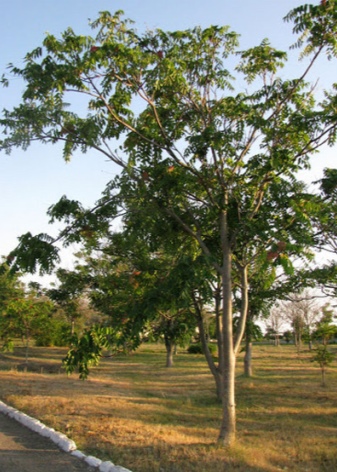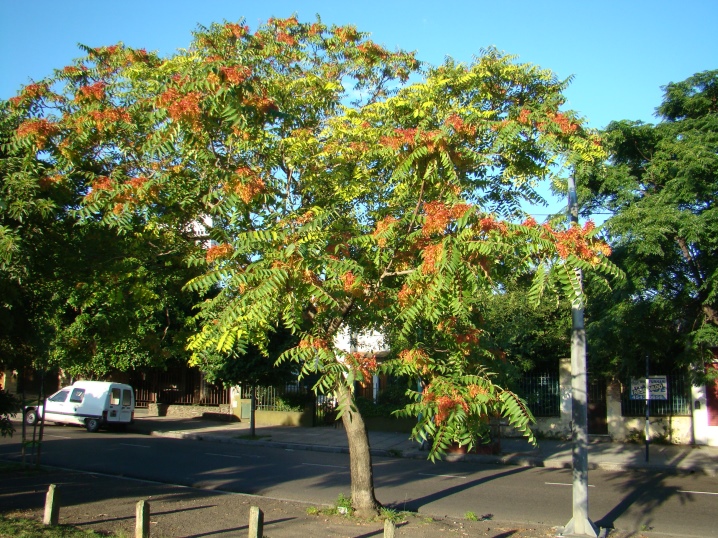Chinese ash: characteristics and cultivation

Each garden, park or square has a large variety of trees and shrubs. Thanks to such cultures, the impression of coziness, tranquility and relaxation is created. An interesting representative of the flora is Chinese ash, which is able to emphasize the originality and serenity of any site.
Description of the tree
Chinese ash is a tree that belongs to the genus Shimaruba. Other names for this long-liver are the highest Ailant, Chumak. This luxurious representative of flora can reach a height of about 20-30 meters, while having a thickness of 0.5 meters. Ash is characterized by a dark gray bark of increased smoothness and the presence of rare notches on it.
The unpaired foliage of the pinnate-complex type has a palm-like appearance and can grow up to 60 cm in length. Green leaves are usually equipped with 3-4 blunt ends. They have a smooth surface on the top and rough on the bottom.


After touching the foliage, you can feel a pungent unpleasant scent.
The flowers of ayllant are small bisexual, usually of a light green color. They are located on a thin panicle 20 cm long. The flowering period of the culture is June-August. In some cases, repeated autumn flowering is observed.
The roots of the Chumak are quite powerful. This representative of the flora loves moisture, therefore it has long roots that extract useful substances necessary for growth and development from the depths of the soil. The culture is frost-resistant, in adulthood it can tolerate temperatures up to 20 degrees below zero.


Chinese ash has high-quality dense wood, therefore, it is used for cladding furniture, ship cabins, and aircraft saloons. Souvenir crafts are also made from it.
Ailanth wood is a valuable raw material from which high quality paper is produced. Since ancient times, this tree was grown for decorative purposes and not only. The juice of this representative of the flora
It is used for the production of medicinal substances, as well as varnish, oil paint. It found its use in the embalming of corpses. Ailanthus foliage is characterized by bactericidal, antiviral properties, therefore it was previously used as a salvation from dysentery and leprosy.


Distribution locations
China is considered the birthplace of Chinese ash, since it was in this country that it was cultivated. Nowadays, this tree is found in almost every country. Especially Ailanth prefers subtropics and warm areas of temperate bands. In the North of America and in European regions, Chinese ash is grown as an ornamental representative of the flora.
In England, the Chumak adorns London parks and squares with its presence. The tree was brought to Ukraine and Russia in order to feed them a silkworm. Today in the south of Ukraine you can find large areas with ailant plantations. He is a frequent representative of the flora of the Crimea and the North Caucasus.



Planting and leaving
Planting Chinese ash can be done with both seeds and seedlings.
Planting seeds
This long and laborious method of growing Chinese ash on your site cannot guarantee that the seeds will sprout for sure, and the plants will be healthy and strong. If you want to plant a tree on your territory, you should use the seed specimens, and not the offspring. Sowing of seed is carried out in the fall. Before sending the seeds to the ground, they should be soaked in warm water and kept for several days. After that, you need to decide on a site for sowing.


The choice of territory should be deliberate, since this culture cannot be transplanted.
The reason for this is the poor ability to adapt to the new soils and microclimate of the site. Sowing seeds is best in a shaded area free from drafts and excessive sunlight. The presence of a large amount of nutrients in the soil is not necessary, since in any case the gardener will need to fertilize the soil. A plot with dimensions of 3 by 3 m must be carefully dug up, eliminating weeds and old roots from it. After that, the land should be fertilized with manure and sprinkled with ash. Sowing of the soaked seed can be started in a day. A meter of soil usually takes about 4 kg of Chinese ash seed. Each of the grains must be buried in the ground to a depth of 5 cm, then sprinkle with a substrate and water. The appearance of the first shoots can be seen within 3-4 weeks from the moment of planting. In 12 months, the culture can grow by 1-3 m.


Planting a seedling
This method of planting ailant can be called faster and more effective, since the seedling is able to take root in the ground much faster than the seed sprout. If the grower chooses the right soil, and also takes good care of the plant, then it can adapt in a few weeks.
The main rules for caring for a chumak are regular watering and feeding. Irrigation of the crop should be moderate from the moment of planting. Do not use cold water for this procedure.
The best option would be a liquid heated in the sun. It is better if it is river or rain.


Chinese ash has a very positive attitude to various dressings. During fertilization, gardeners should take into account the following points:
-
for the first time ailant needs to be fertilized after cultivation, for this purpose it is worth using both mineral and organic substances;
-
the rest of the fertilization procedures are carried out one year after the first and only in the spring;
-
substances for feeding should be selected taking into account the characteristics of the soil.

According to the recommendations of experienced gardeners, Chinese ash is the tree that needs to be insulated for the winter season. To this end, it should be wrapped in cardboard, and the section of the trunk should be wrapped with roofing material, which will prevent the attack of rodents and animals.

Reproduction methods
A tree, like a shrub, can multiply by rhizome parts and seeds. The latter must be stored in a cloth bag, and the room must be dry and cool. Often it is propagated by offspring and cuttings. but there are cases when the culture independently gives young shoots from which areas can overgrow.
Diseases and pests
Chinese ash often suffers from rodents and small animals that gnaw its trunk in winter. To prevent such an unpleasant situation, it is recommended to protect the plant with wrapping. TO the culture is immune to infections and fungal ailments, so it rarely gets sick.
Ailant the highest is an unpretentious plant that can be easily planted on your site. According to gardeners' reviews, this tree causes discomfort due to its rapid spontaneous growth on the site.

































































The comment was sent successfully.